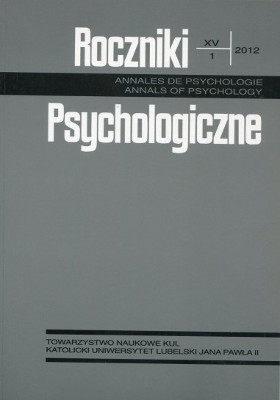The impact of self-threat and personal engagement on distortions of memory reports
Abstract
The main aim of the presented experiment was to verify whether self-threat and low engagement influence memory processes of eyewitnesses, including their susceptibility to misinformation. The results replicated the eyewitness misinformation effect. Also, according to the hypotheses, high engagement and self-threat resulted in better memory, enhancing the performance of non-misled participants. However, the hypotheses stating that self-threat and engagement influence the susceptibility to misinformation were not confirmed. The enhancement of memory of non-misled subjects was interpreted in terms of increased motivation to self-protecting and more careful processing of the material to be remembered. The lack of relationship between self-threat, engagement and the susceptibility to misinformation could be due to the fact that self-threat and engagement act oppositely: on the one hand, they enhance the memory of the original event, but they also increase the memory of misinformation. Thus, no general effect is present.
References
Apsler, R., Sears, D. O. (1968). Warning, personal involvement, and attitude change. Journal of Personality and Social Psychology, 9, 162-166.
Bellezza, F. S. (1984). The self as a mnemonic device: The role of internal cues. Journal of Personality and Social Psychology, 47, 506-516.
Belli, R. F. (1989). Influence of misleading postevent information: Misinformation interference and acceptance. Journal of Experimental Psychology, 118, 72-85.
Campbell, J. M., Edwards, M. S., Horswill, M. S., Helman, S. (2007). Effects of contextual cues in recall and recognition memory: The misinformation effect reconsidered. British Journal of Psychology, 98, 485-498.
Craik, F. I. M., Lockhart, R. S. (1972). Levels of processing: A framework for memory research. Journal of Verbal Learning and Verbal Behavior, 11, 671-684.
Dalton, A. L., Daneman, M. (2006). Social suggestibility to central and peripheral misinformation. Memory, 14, 486-501.
Eagly, A. M., Kulesa, P., Chen, S., Chaiken, S. (2001). Do attitudes affect memory? Tests of the congeniality hypothesis. Current Directions in Psychological Science, 10, 5-9.
Festinger, L. (1957/2007). Teoria dysonansu poznawczego. Warszawa: Wydawnictwo Naukowe PWN.
Greenwald, A. G. (1980). The totalitarian ego: Fabrication and revision of personal history. American Psychologist, 35, 603-618.
Greenwald, A. G. (1985). Personaliza versus zasada wewnętrznej jedności osoby. Przegląd Psychologiczny, 28, 887-923.
Greenwald, A. G., Pratkanis, A. R. (1988). „Ja” jako centralny schemat postaw. Nowiny Psychologiczne, 2, 20-70.
Gur, R. C., Sackeim, H. A. (1979). Self-deception: A concept in search of a phenomenon. Journal of Personality and Social Psychology, 37, 147-169.
Kendzierski, D. (1980). Self-schemata and scripts: The recall of self-referent and scriptal information. Personality and Social Psychology Bulletin, 6, 23-29.
Lindsay, D. S., Johnson, M. K. (1989). The reversed eyewitness suggestibility effect. Bulletin of the Psychonomic Society, 27, 111-113.
Loftus, E. F. (1979). Reactions to blatantly contradictory information. Memory and Cognition, 7, 368-374.
Loftus, E. F., Miller, D. G., Burns, H. J. (1978). Semantic integration of verbal information into a visual memory. Journal of Experimental Psychology: Human Learning and Memory, 4, 19-31.
Łukaszewski, W. (1978). Struktura ja a działanie w sytuacjach zadaniowych: empiryczne studium nad funkcjami osobowości. Wrocław: Wydawnictwo Uniwersytetu Wrocławskiego.
Markus, H. (1977). Self-schemata and processing information about the self. Journal of Persona- lity and Social Psychology, 35, 63-78.
Paszkiewicz, E. (1974). Ja a zachowanie. Psychologia Wychowawcza, 2, 192-209.
Petty, R. E., Cacioppo, J. T., Goldman, R. (1981). Personal involvement as a determinant of argument-based persuasion. Journal of Personality and Social Psychology, 41, 847-855.
Pezdek, K. (1977). Cross-modality semantic integration of sentence and picture memory. Journal of Experimental Psychology: Learning, Memory, and Cognition, 3, 515-524.
Polczyk, R. (2007). Mechanizmy efektu dezinformacji w kontekście zeznań świadka naocznego. Kraków: Wydawnictwo Uniwersytetu Jagiellońskiego.
Reykowski, J. (1979). Motywacja: postawy prospołeczne i osobowość. Warszawa: Państwowe Wydawnictwo Naukowe.
Rogers, T. B., Kuiper, N. A., Kirker, W. S. (1977). Self-reference and the encoding of personal information. Journal of Personality and Social Psychology, 35, 677-688.
Schacter, D. L. (2003). Siedem grzechów pamięci. Warszawa: Państwowy Instytut Wydawniczy.
Sedikides, C. (1993). Assessment, enhancement, and verification determinants of the self-evaluation process. Journal of Personality and Social Psychology, 65, 317-338.
Sedikides, C., Green, J. D. (2004). What I don’t recall can’t hurt me: Information negativity versus information inconsistency as determinants of memorial self-defense. Social Cognition, 22, 4-29.
Sedikides, C., Strube, M. J. (1995). The multiply motivated self. Personality and Social Psycho- logy. Bulletin, 21, 1330-1335.
Sedikides, C., Strube, M. J. (1997). Self-evaluation: To thine own self be good, to thine own self be sure, to thine own self be true, and to thine own self be better. W: M. P. Zanna (red.), Advances in Experimental Social Psychology, 29, 209-269. New York: Academic Press.
Symons, C. S., Johnson, B. T. (1997). The self-reference effect in memory: A meta-analysis. Psychological Bulletin, 121, 371-394.
Szpitalak, M., Polczyk, R. (2010). Warning against warnings: Alerted subjects may perform worse. The impact of misinformation, involvement and warning on eyewitness testimony. Polish Psychological Bulletin, 41, 105-112.
Szpitalak, M., Polczyk, R. (w opracowaniu). Kwestionariusz Oceny Pracoholizmu.
Tousignant, J. P., Hall, D., Loftus, E. F. (1986). Discrepancy detection and vulnerability to misleading postevent information. Memory and Cognition, 14, 329-338.
Wojciszke, B. (2003). Człowiek wśród ludzi. Zarys psychologii społecznej. Warszawa: Wydawnictwo Naukowe Scholar.
Wright, D. B., Stroud, J. N. (1998). Memory quality and misinformation for peripheral and central objects. Legal and Criminological Psychology, 3, 273-286.
Zaragoza, M. S., Lane, S. M. (1994). Source misattributions and the suggestibility of eyewitness memory. Journal of Experimental Psychology: Learning, Memory, and Cognition, 20, 934-945.
Copyright (c) 2012 Roczniki Psychologiczne

This work is licensed under a Creative Commons Attribution-NonCommercial-NoDerivatives 4.0 International License.


